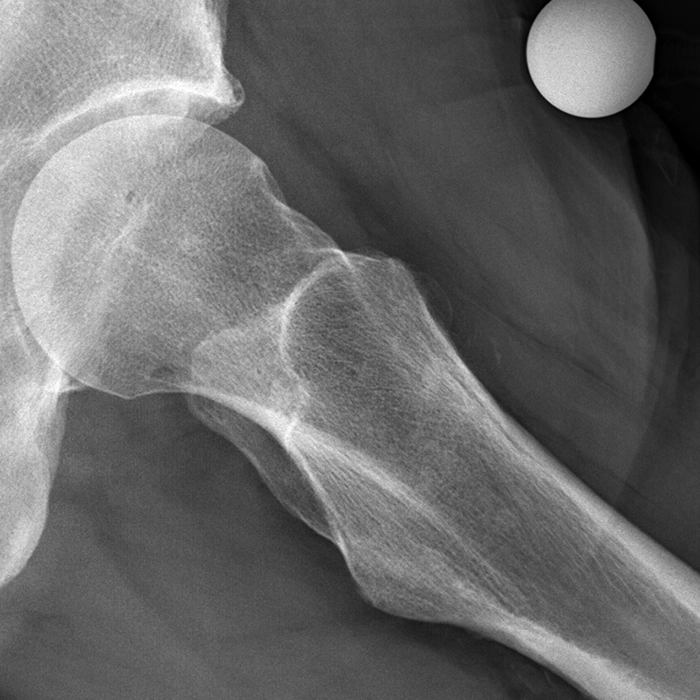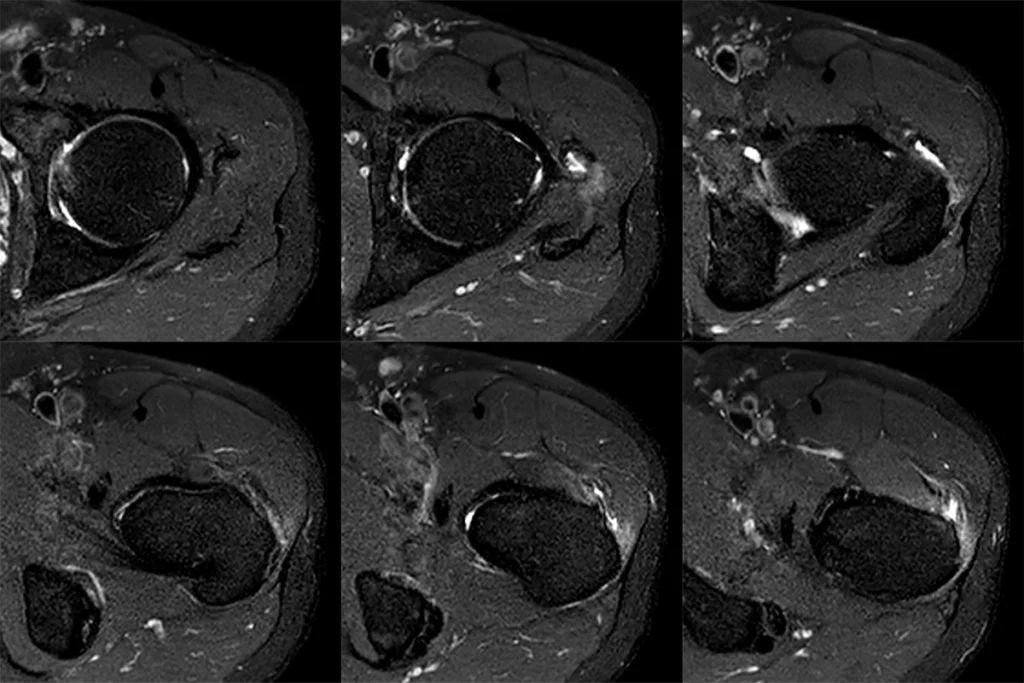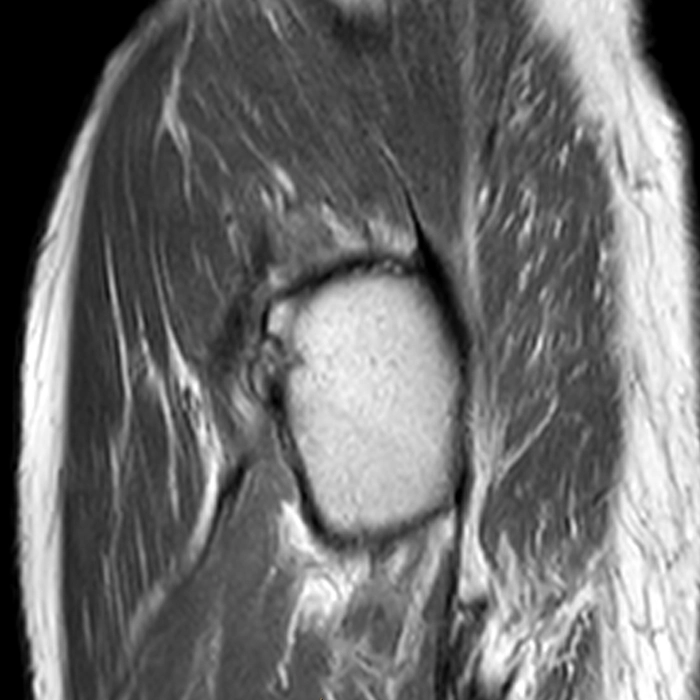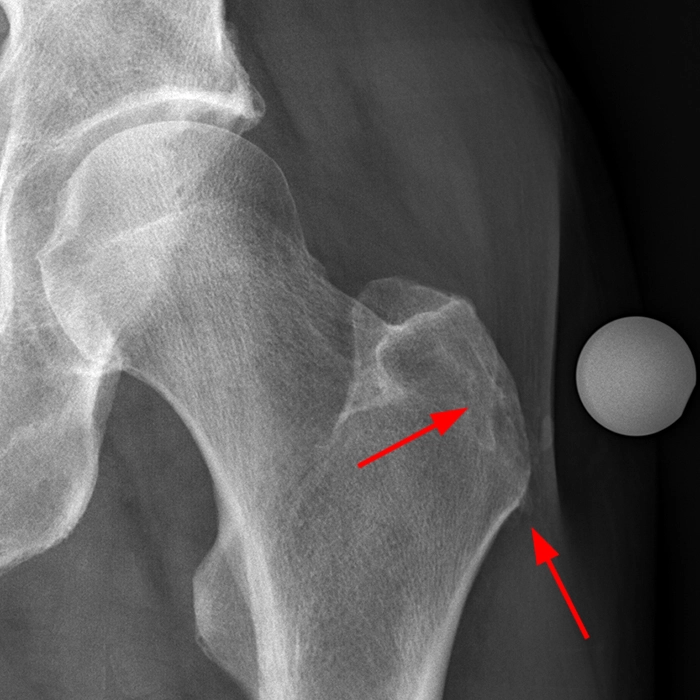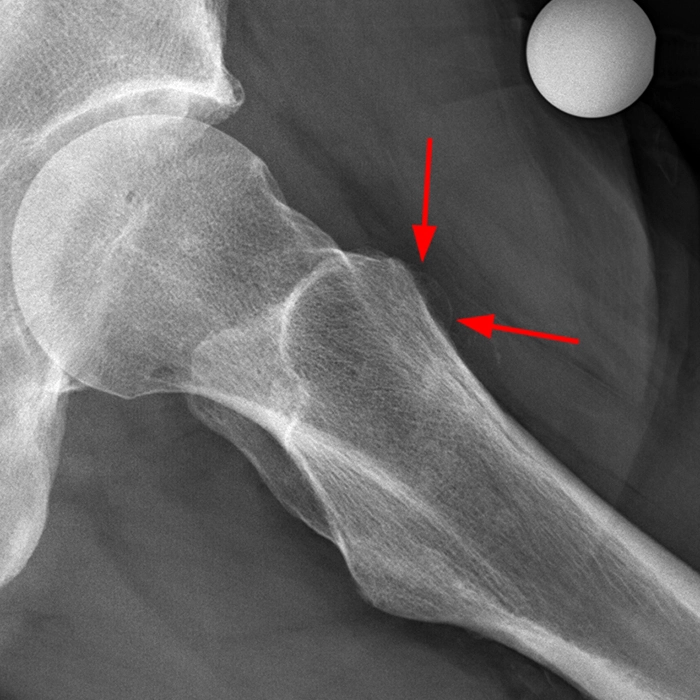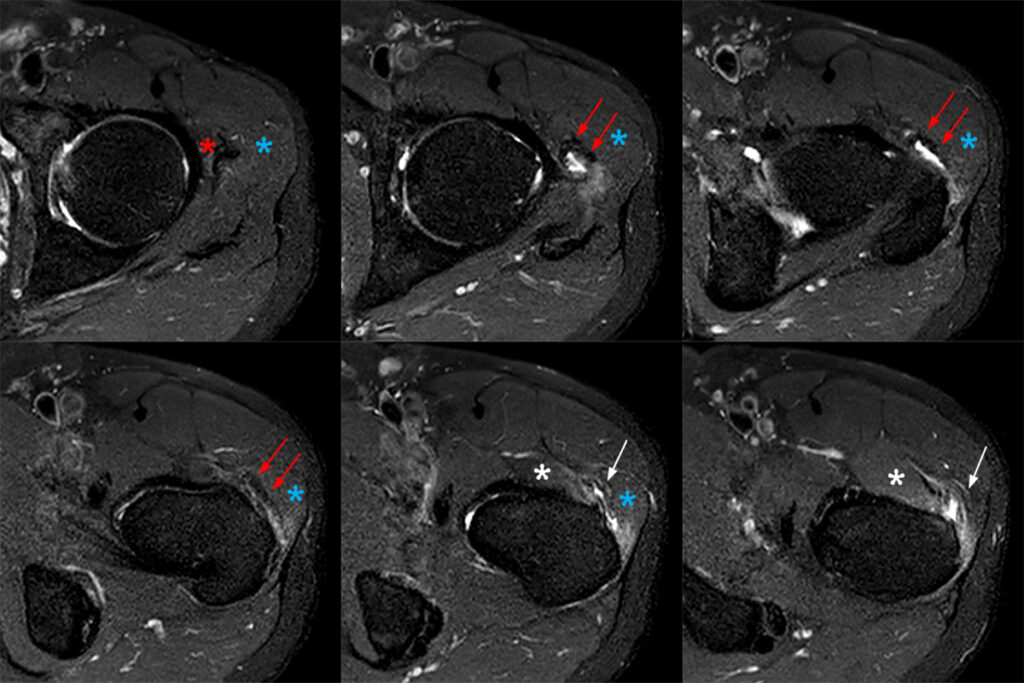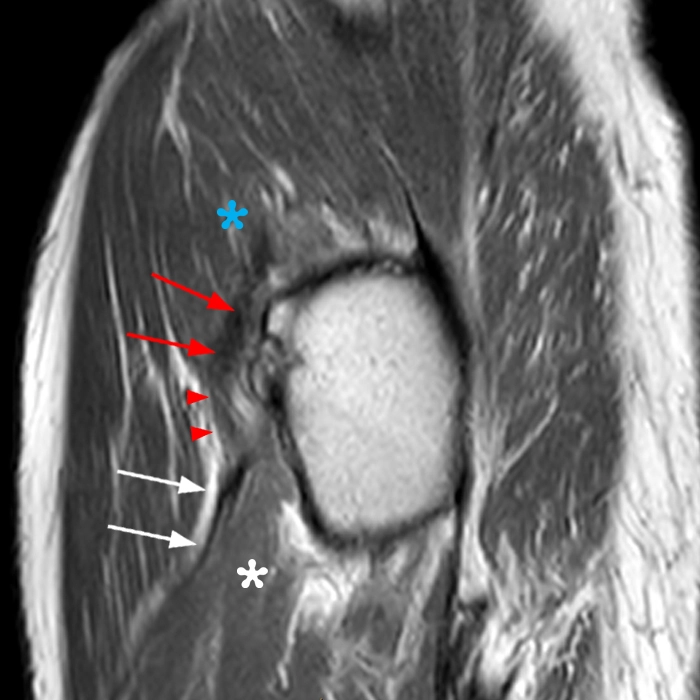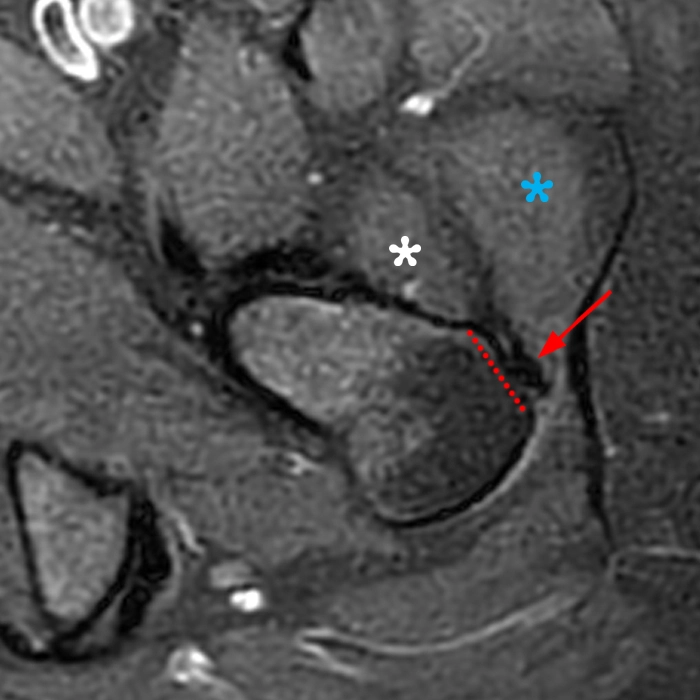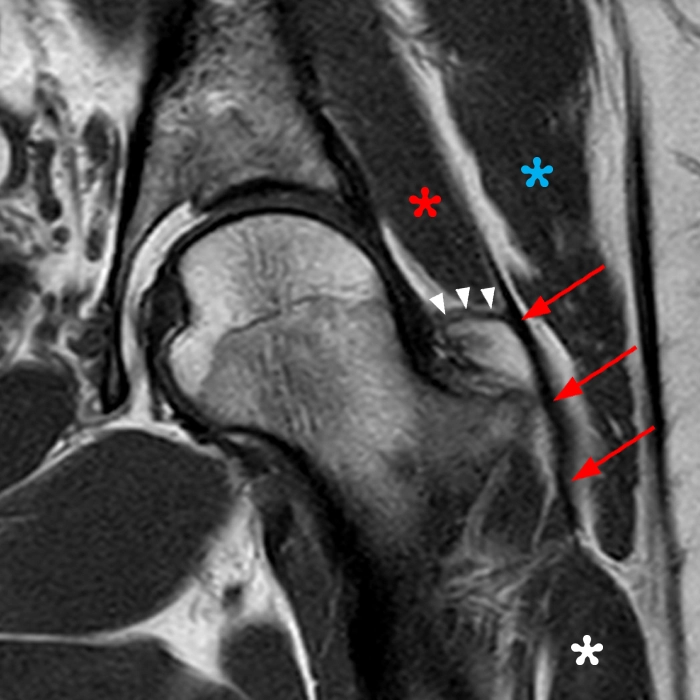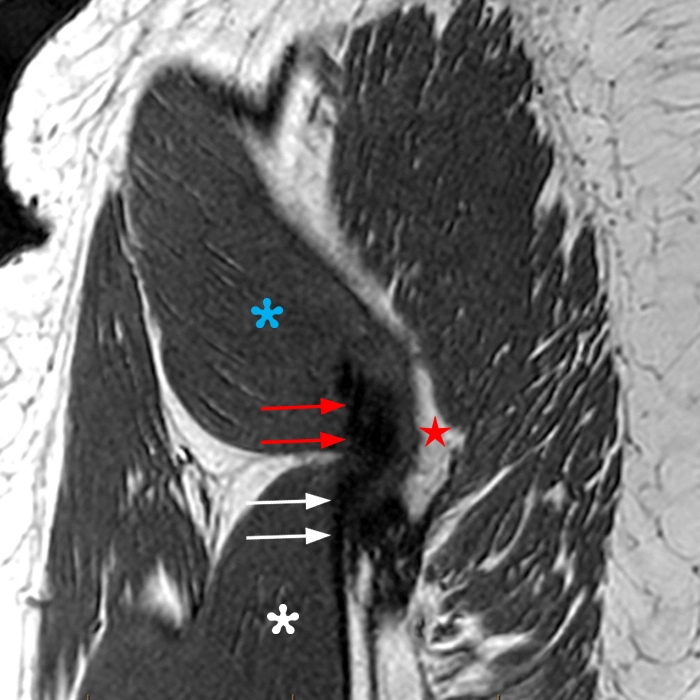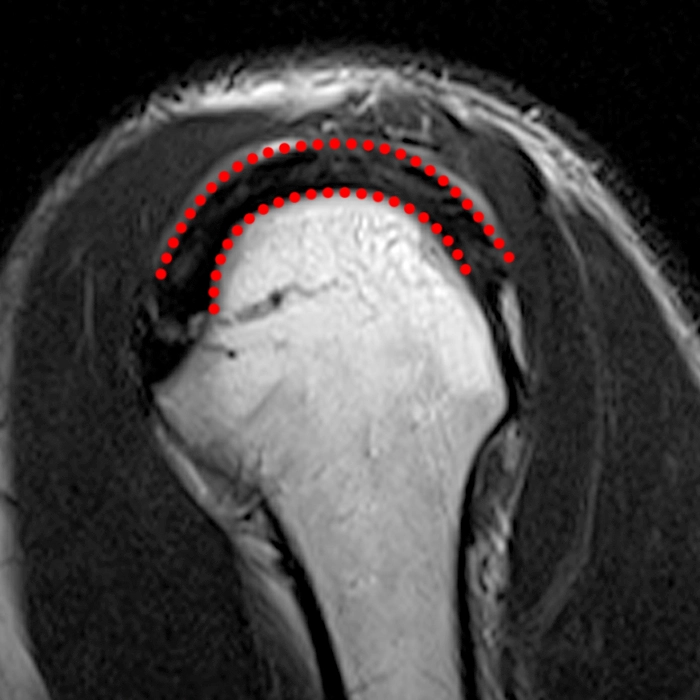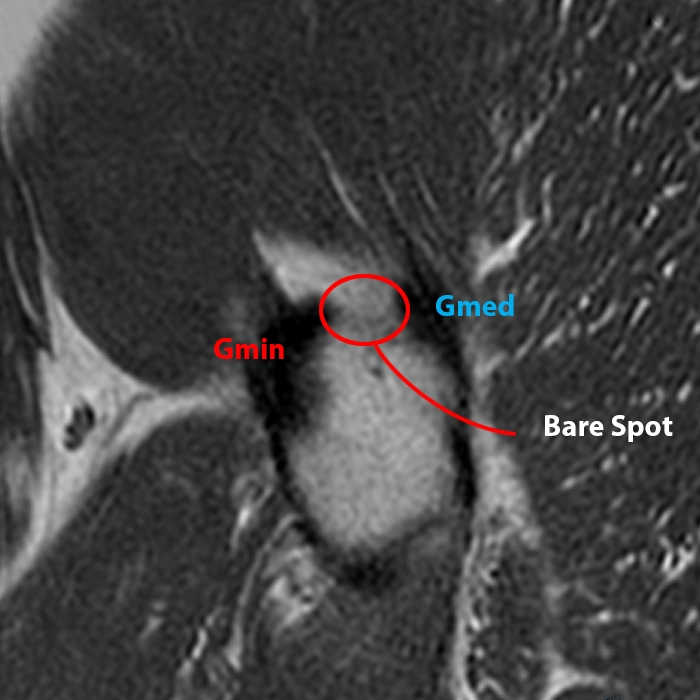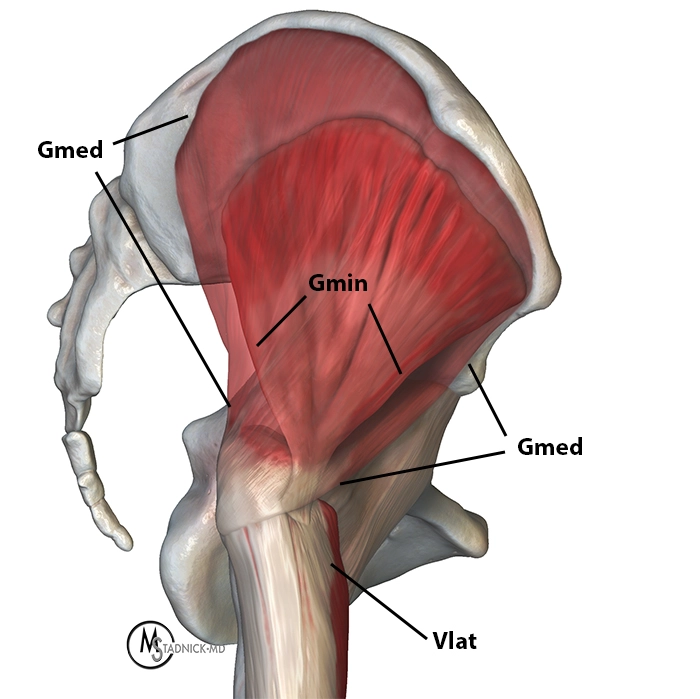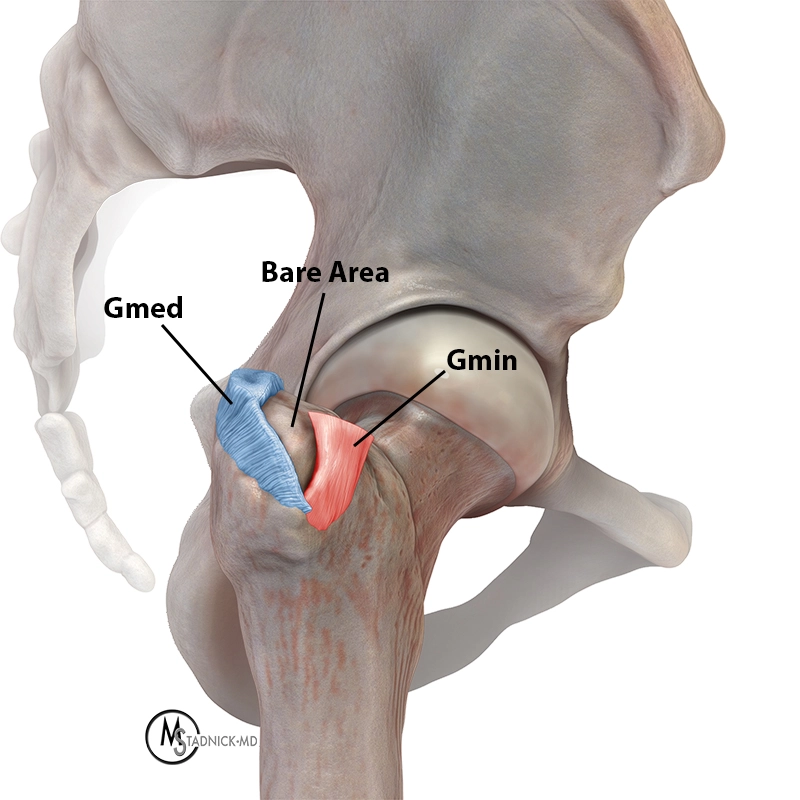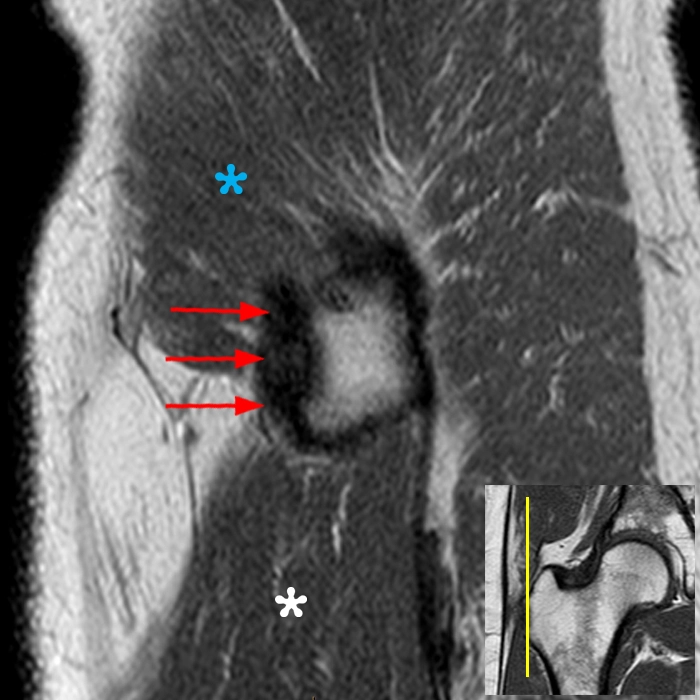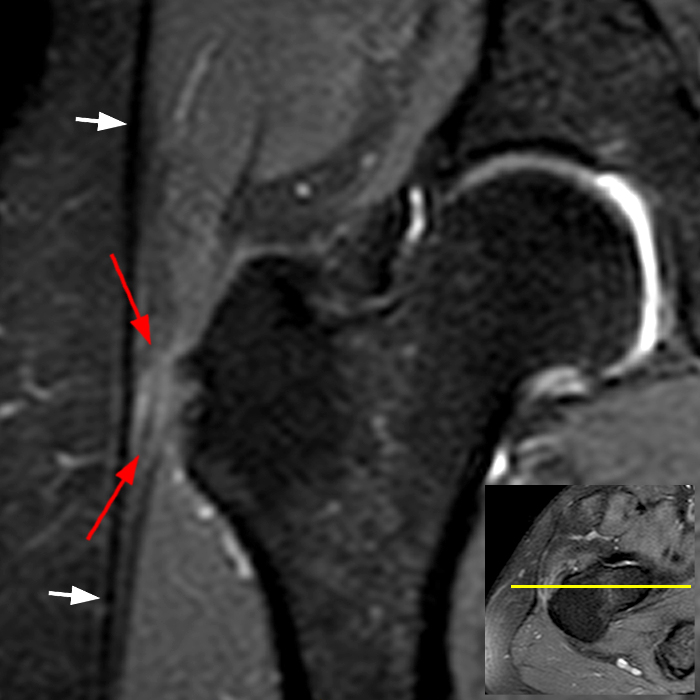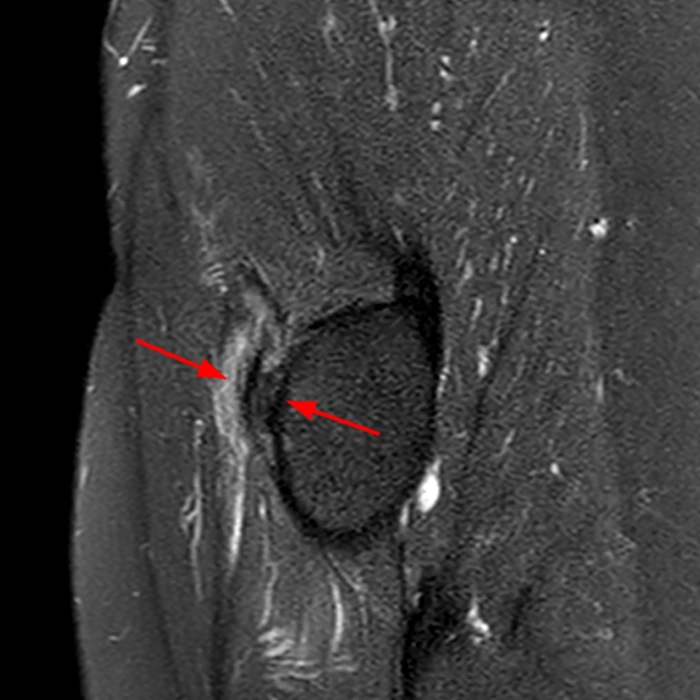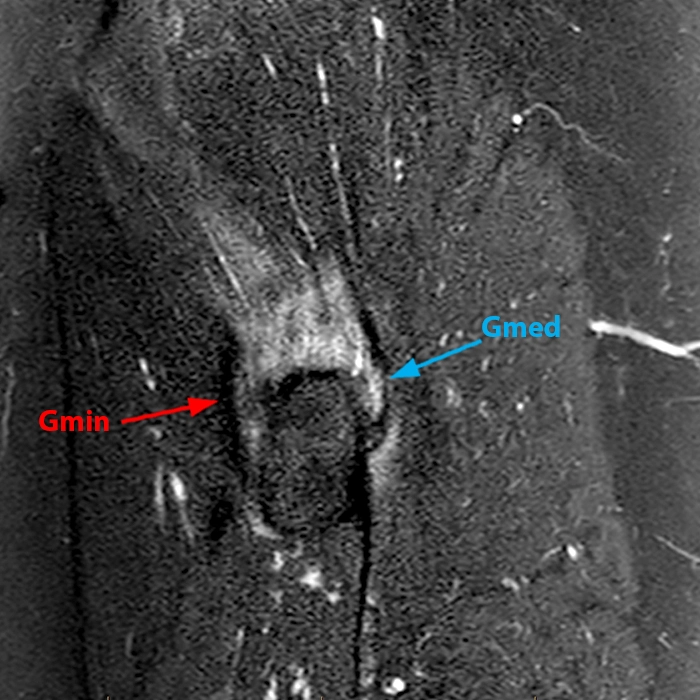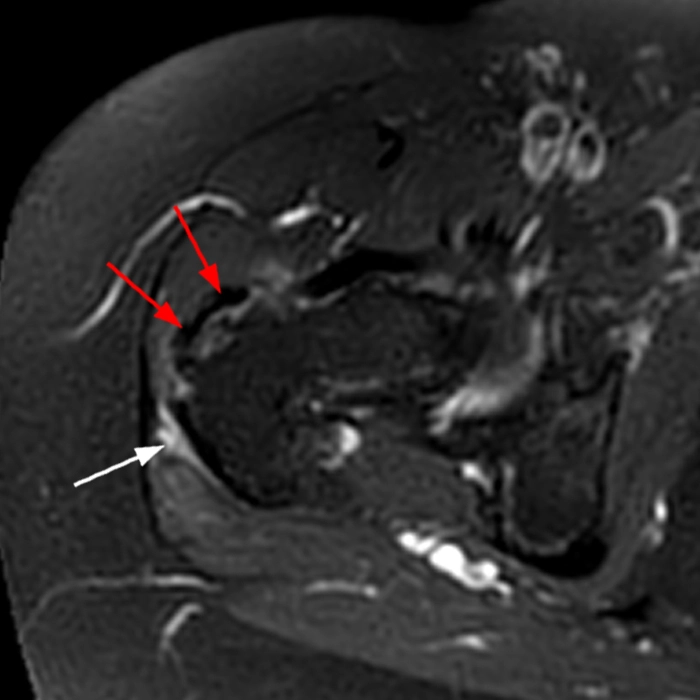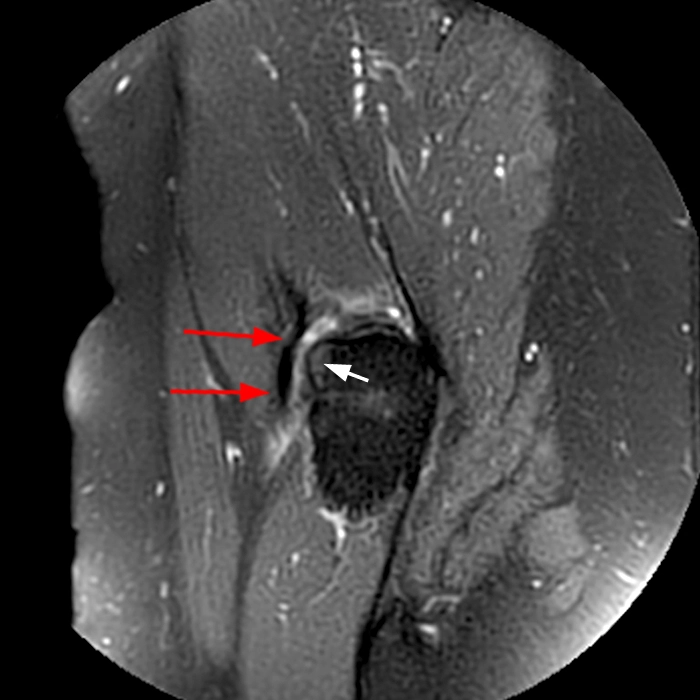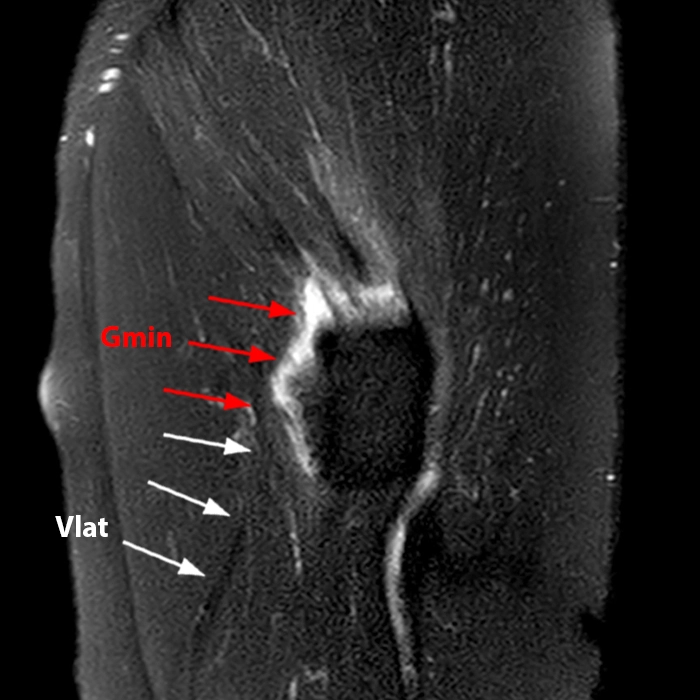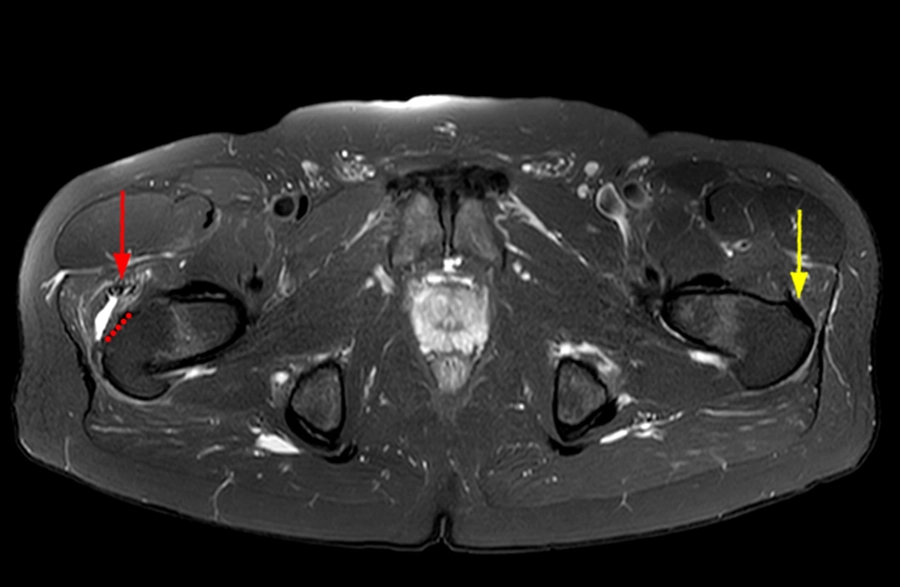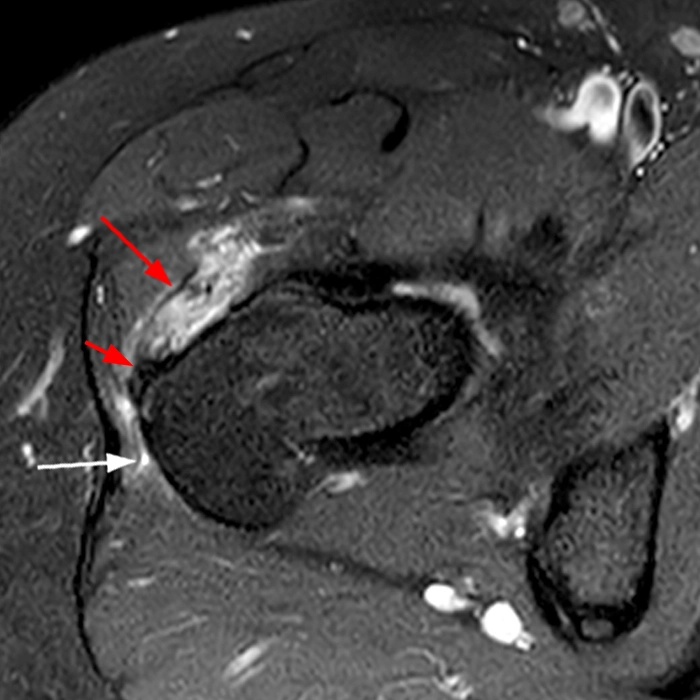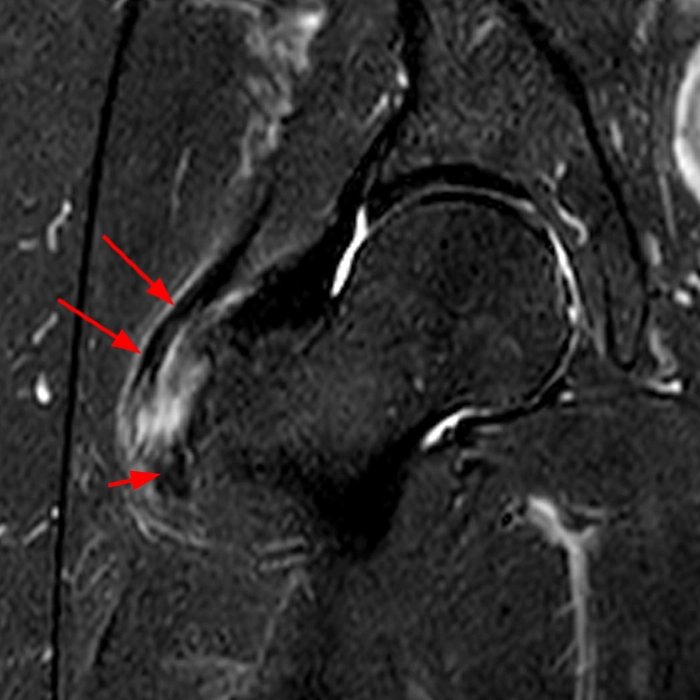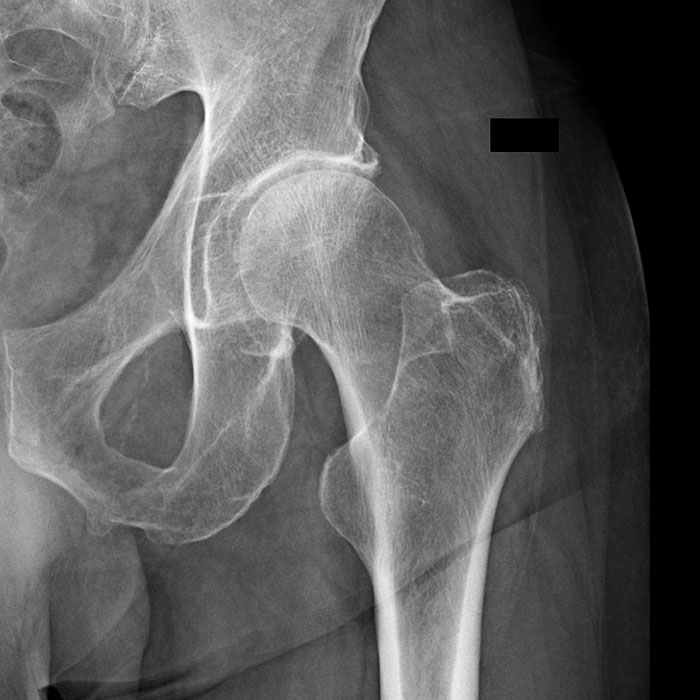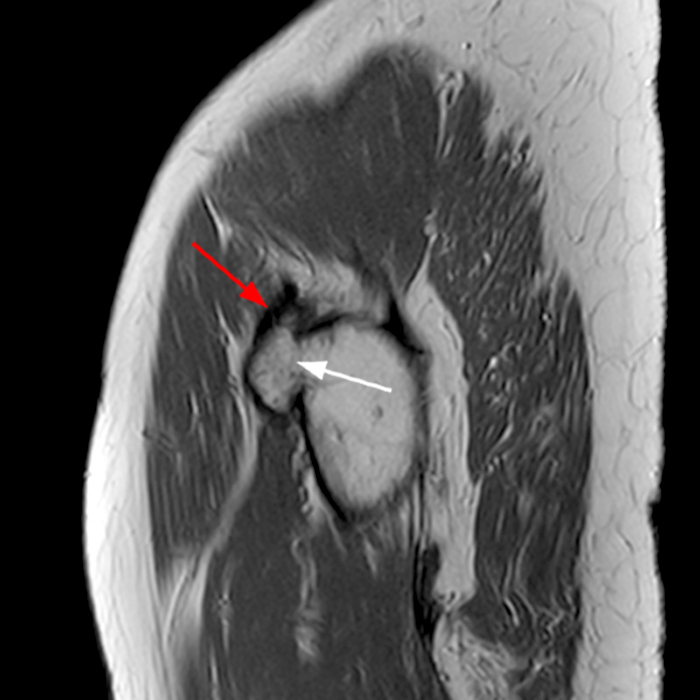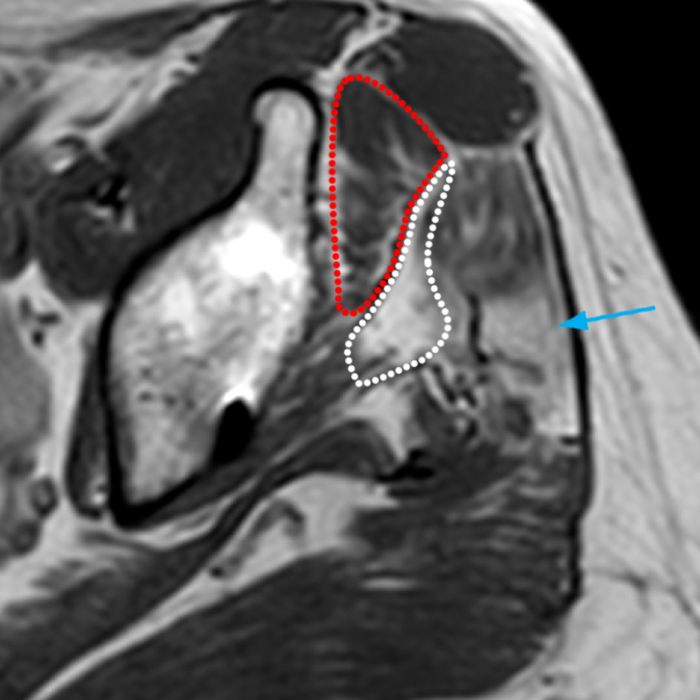Clinical History: A 70 year-old male presents with chronic lateral hip pain that recently worsened after slipping. Frontal and frog-leg radiographic views of the left hip (Fig 1a, 1b), contiguous axial fat-suppressed proton density-weighted images of the left hip (Fig 1c), and a sagittal proton density-weighted image of the left hip showing the greater trochanter (Fig 1d) are provided. What are the findings? What is your diagnosis?
Figure 2:
The initial AP radiograph (2a,b) shows small enthesophytes (red arrows) on the greater trochanter. No fracture or osseous lesion. Mild osteoarthritis of the left hip with small peripheral osteophytes and mild joint space narrowing. The frog-leg lateral radiograph (2b) shows the enthesophytes (red arrows) along the anterior facet of the greater trochanter to better advantage. Figure 2c – Sequential axial fat-suppressed proton density-weighted images of the left hip demonstrate a complete insertional tear of the gluteus minimus tendon (red arrows) without retraction. The entire insertional footprint is stripped off the anterior facet of the greater trochanter with slight anterior and medial displacement, with the distal fibers contiguous with the vastus lateralis proximal muscle (white asterisk) and tendon (white arrows). (Blue asterisk = gluteus medius muscle; red asterisk=gluteus minimus muscle) Figure 2d – Sagittal proton density-weighted image of the lateral left hip at the level of the greater trochanter with complete stripping of the gluteus minimus tendon (red arrows) from its insertion on the anterior facet. The gluteus minimus tendon is tethered by a continuation with the proximal vastus lateralis tendon (white arrows) preventing retraction. Enthesophytes are seen along the anterior facet of the greater trochanter> The vastus lateralis muscle is also indicated (white asterisk).
Introduction
Greater trochanteric pain syndrome (GTPS) is a common cause of lateral hip pain in adults. Previously thought to be related to trochanteric bursitis, we now know that tendinopathy or tearing of the gluteus medius (Gmed) and gluteus minimus (Gmin) are a leading cause of GTPS.1 Patients with lateral hip pain can present acutely, but more commonly with chronic longstanding symptoms of dull/insidious pain along the proximal lateral hip that is worsened when lying on the affected side or with walking/climbing stairs.2 On physical exam, patients with GTPS have tenderness to palpation along the anterior aspect of the greater trochanter and reproducible pain with weakness on resisted abduction of the hip.3 Peak prevalence of GTPS and gluteal tendinopathy can be found in female patients over 30 years of age 4 Over the past 15 years MRI has emerged as the primary imaging tool for interrogating the gluteal muscles and their tendinous insertions.5 This Radsource Web Clinic will focus on gluteus minimus pathology with a review of the relevant anatomy, the MRI appearance of common tear patterns, secondary signs of Gmin pathology, two common pitfalls during MRI interpretation, and a brief review of treatment options.
Relevant Anatomy and Function
The gluteus minimus muscle origin has a broad fan shape, arising from the anterior aspect of the external iliac fossa with a wide muscular attachment. The insertion has two distinct components, a main tendon attaching to the anterior facet of the greater trochanter and a thinner short muscular or capsular attachment along the ventral superior capsule of the hip joint. Functionally, the Gmin main tendon acts as a hip flexor, an abductor and an internal/external rotator depending on the position of the femur. The capsular attachment helps to stabilize the head of the femur within the acetabulum by tightening the capsule and applying compressive pressure to the femoral head.6,7 The distal fibers of the main GMin tendon are contiguous with the origin of the vastus lateralis (Vlat). (Fig 3a-d)
Figure 3:
Axial fat-suppressed proton density-weighted image (3a) of the distal tendinous insertion of the gluteus minimus. The anterior facet of the greater trochanter (red dotted line) and the insertional footprint of the Gmin tendon (red arrow) are indicated. Coronal T1-weighted image (3b) demonstrating the dominant main tendon (red arrows) extending down to its insertion and the smaller capsular attachment (white arrowheads). Sagittal proton density image (3c) depicting the anterior facet (red dotted line) and insertional footprint (red arrow) of the Gmin tendon. Thin slice Sagittal 3D_MFFE image (3d) slightly more lateral than Fig 3c showing the contiguous anatomy of the distal Gmin insertional tendon (red arrows) and the proximal origin of the vastus lateralis (white arrows). (On all images, the red asterisk is the Gmin muscle, the blue asterisk is the Gmed muscle, the white asterisk is the Vlat muscle, and the red star is the bone of the greater trochanter.)
Figure 4:
Sagittal T2-weighted image (4a) of the shoulder rotator cuff at the level of the greater tuberosity. The supraspinatus and infraspinatus rotator cuff tendons (outlined with red dotted lines) are similar in thickness with complete overlap and a continuous covering of the humeral head. Sagittal proton density image of the hip (4b) at the periphery of the greater trochanter shows the insertion of the Gmin tendon along the anterior facet and the insertion of the Gmed tendon on the superoposterior facet. Along the superior aspect of the lateral facet there is a bare area where the tendons appear discontinuous.
Figure 6:
3D Models of the greater trochanter with muscles (6a), showing the larger Gmed muscle belly covering most of the Gmin, extending anterior and distal to the Gmin insertion site. Stripped away image (6b) showing a detailed representation of the Gmin (red) and Gmed (blue) tendon insertion sites with the anatomic bare area along the superior portion of the lateral facet.
Common Gluteus Minimus Pathology
GTPS due to gluteal tendinopathy is a common cause of lateral hip pain; below we will focus on the MRI findings pertaining to the gluteus minimus.
Tendinosis and peritendon edema
The most common pathology of the gluteus minimus tendon seen on MRI is degenerative tendinosis with mild adjacent peritrochanteric edema (Fig 7a-c).
Figure 7:
Axial proton density-weighted fat-suppressed image (7a) of the hip at the level of the greater trochanter anterior facet demonstrating tendinosis with edema and interstitial splitting of the insertional gluteus minimus tendon (red arrow) with mild peritrochanteric edema (white arrow). Sagittal proton density-weighted image (7b) shows mild tendinosis of the insertional Gmin tendon (red arrow) with complete attachment to the anterior facet. Coronal proton density-weighted fat-suppressed image (7c) demonstrating peritrochanteric edema (red arrows) deep to the iliotibial band (short white arrows).
Partial tearing – Chronic
Many patients over 60 years of age have some degree of age-related degenerative tendinosis involving the gluteus minimus tendon with a clear increased prevalence in female patients. The pathology is thought to be related to repetitive tensile shearing and compressive stress along the deep fibers of the insertional tendon which can ultimately progress towards partial or complete tearing11 (Fig8a,b). Figure 8: Axial T2-weighted image (8a) with fat-suppression shows a degenerated gluteus minimus tendon (red arrow) with partial tearing at the anterior facet and moderate adjacent edema with mild trochanteric bursal fluid (white arrows). Sagittal proton density-weighted fat-suppressed image (8b) demonstrates partial tearing of the gluteus minimus tendon at its anterior facet insertion.
Combined degenerative partial tears of the Gmin and Gmed tendons
Combined degenerative partial tearing of the Gmin and Gmed tendons is a common tear pattern with the tearing typically involving the deep posterior fibers of the Gmin and the anterior Gmed fibers along the lateral facet attachment. (Fig 9a,b)
Complete gluteus minimus insertional tear without retraction
The final common gluteus minimus tear pattern is a complete tear without retraction. Our experience at Radsource anecdotally indicates this tear pattern is common but underrecognized, often described as partial tearing or severe tendinosis due to the lack of retraction. White et al. published a similar opinion with supporting data in a 2021 study of gluteus minimus tears.12 In their study, the vast majority (38/40) of complete tears of the distal insertional gluteus minimus were not retracted. This lack of retraction is another key difference between the rotator cuff of the shoulder and the gluteus minimus tendon of the hip and can be explained anatomically. The distal fibers of the main gluteus minimus tendon are continuous with the proximal vastus lateralis which serves to tether the gluteus minimus in place, limiting retraction. It is also theorized that the small capsular attachment of the gluteus minimus tendon helps to anchor and prevent Gmin retraction (Fig 2c,d and Fig 10a,b). On axial images, the completely torn Gmin tendon often shifts anterior and medial to its native position, a clue the tendon tear is complete (Fig 11a-c). Figure 10: Axial (10a) and sagittal (10b) proton density-weighted fat-suppressed images of the hip demonstrate complete distal gluteus minimus tendon tear (red arrows) with small amount of peritrochanteric bursal fluid signal (white arrow). The entire footprint is torn off the anterior facet but there is no tendon retraction. Figure 11: Axial (11a) and sagittal (11b) proton density-weighted fat-suppressed small field of view images of the hip demonstrate complete distal gluteus minimus tear with anterior and medial shift of the degenerated tendon. There is no retraction due to tethering/continuity with the proximal vastus lateralis. Whole pelvis large field of view T2-weighted axial image with fat-suppression (c) reinforces the amount of anterior and medial displacement of the torn right gluteus minimus tendon (red arrow) from the footprint (dotted line) compared to the normal left side (yellow arrow).
Partial tearing – Acute/Subacute
Acute gluteus minimus tearing is less common and can be isolated muscle injury or involve both the muscle and insertional tendon. (Figs 13a,b)
Figure 13:
60-year-old female with acute right lateral hip pain after a fall 2 weeks ago. Axial (12a) and coronal (12b) proton density-weighted fat-suppressed images of the right hip demonstrate an acute tear along the anterior insertion of an otherwise normal gluteus minimus tendon (large red arrows). The posterior fibers of the insertional tendon remain intact (small red arrow) and there is a small amount of edema in the trochanteric bursae (white arrow). The patient history, lack of tendinosis in the tendon, and the atypical tear pattern involving the anterior fibers rather than the posterior fibers is indicative of an acute/subacute tear.
Isolated Gluteus Minimus muscle injury
Rarely, trauma can cause isolated muscle injury to the gluteus minimus (Fig 14).
Figure 14:
Coronal STIR image of the right hip demonstrating moderate intramuscular signal abnormality (white arrows) consistent with strain in a 22-year-old football player following acute trauma. The insertional gluteus minimus tendon (red arrows) is intact. Subsequent follow-up images showed complete resolution of the abnormal muscle signal/strain after rest.
Enthesopathy is commonly associated with Gluteal tendon tear.
Several studies have shown that trochanteric enthesopathy or bone spurs are associated with tendinopathy of the gluteal tendons. In a study by Steinert et al., trochanteric enthesophytes of greater than or equal to 2mm had a positive predictive value of >90% for underlying gluteal tendinopathy.15 In our index case, Fig 2b, enthesophytes are present along the anterior facet of the greater trochanter. Below, Fig 15a,b demonstrates large enthesophytes on radiographs and underlying gluteal tendinopathy. Radiographically, the enthesophytes along the anterior facet are best seen on the frog-leg lateral view.
Figure 15:
AP (15a) and frog-leg (15b) radiographs of the left hip. AP radiographs underestimate the size of anterior facet enthesophytes on radiographs. On the frog-leg lateral view, a large frond-like enthesophyte (white arrows) projects anteriorly from the anterior facet of the greater trochanter. A sagittal proton density-weighted image (15c) shows the gluteus minimus tendon (red arrow) attaching to the large enthesophyte (white arrow). On more proximal images (not shown) the gluteus minimus tendon demonstrated mild tendinopathy and interstitial splitting.
Fat stripe sign
Similar to other skeletal muscles, atrophy of the gluteal muscles can occur secondary to tendon tears. This atrophy can serve as a diagnostic clue for underlying tendinopathy. Atrophic gluteal muscles combined with increased intergluteal fatty tissue has been termed the “intergluteal fat stripe” sign in a study published by Beicker et al.16 Of note, atrophy of the anterior gluteus minimus is relatively non-specific, found in symptomatic and asymptomatic patients, while fatty atrophy of the posterior gluteus minimus and gluteus medius muscles tends to be more suggestive of a symptomatic condition17(Fig 16a,b).
Figure 16:
Axial (16a) and coronal (16b) proton density-weighted images demonstrate atrophy and fatty infiltration of the posterior aspect of the gluteus minimus muscle (white area) with preservation of the anterior fibers (red area). There is advanced atrophy of the gluteus medius muscle (blue arrow) in this patient with lateral hip pain status post arthroplasty. Both the Gmin and Gmed tendons were completely torn on distal images (not shown).
Treatment options
Treatment for isolated gluteus minimus pathology is typically conservative. Surgery is uncommon and reserved for cases that do not respond to lifestyle modifications, time for healing, physical therapy and/or PRP injections. Rarely is an isolated gluteus minimus tear treated surgically if there isn’t an associated gluteus medius tendon tear. Part of the reason for this conservative treatment strategy is dictated by the anatomy of the Gmed muscle. As we saw back in figures 3c and 6a, the muscle of the Gmed covers the majority of the Gmin insertion. The Gmed muscle effectively blocks access to the Gmin tendon. If a patient is undergoing surgery for a gluteus medius tear, the gluteus minimus tear will often be addressed at the same time. Open or endoscopic approaches are used with similar success and recovery periods. The degenerated tendons are often reattached to the greater trochanter using tendon-bone anchors. Recovery from gluteal surgery is often long and challenging, with expected recovery periods of greater than 6 months and extensive physical therapy.
Figure 17:
Intraoperative images of gluteus minimus repair. A – Probe in the defect showing gap in tendon fibers and exposed greater trochanter bone surface. B – Placement of anchors. C – Placement of suture. D – Closed defect, the trochanter is now covered with tendon and the portions of the suture can be seen at the 11 o’clock position on this image. (Intraoperative images courtesy of J.W. Thomas Byrd, MD, Tennessee Orthopaedic Alliance , Nashville, TN).
Summary and Key Learning Points
- Gluteal tendinopathy is almost always present in patients with GTPS; but gluteal tendinopathy is also commonly present in patients without lateral hip pain. It is important to evaluate for other causes of lateral hip pain on MRI even if gluteal tendinopathy is present.
- The bare/bald spot along the superior aspect of the lateral trochanteric facet between the insertion of the gluteus minimus tendon and the anterior fibers of the gluteus medius tendon insertion should not be mistaken for a tear. This distinction can be made difficult in cases with peritrochanteric edema and bursitis. Understanding the anatomy of the insertional tendons will help avoid this pitfall.
- The gluteus minimus tendon will commonly tear/strip completely off the anterior facet of the greater trochanter but will not retract due to distal tethering by the vastus lateralis. A completely torn gluteus minimus tendon will often shift anteriorly and medially relative to the anterior facet and the contralateral side can often be used as a reference to compare.
- Enthesophytes measuring greater than 2mm on radiographs or MRI are commonly associated with gluteal tendinopathy.
- Atrophy of the anterior gluteus minimus muscle is a nonspecific finding, while atrophy of the posterior gluteus minimus and gluteus medius muscles is more commonly associated with symptomatic gluteal pathology.
References
- Bird PA, Oakley SP, Shnier R, Kirkham BW. Prospective evaluation of MRI and physical examination findings in patients with greater trochanteric pain syndrome. Arthritis Rheum 2001;44:2138-2145. ↩
- Cormier G, Berthelot JM, Maugars Y. Gluteus tendon rupture is underrecognized by French orthopaedic surgeons: results of a mail survey. Joint Bone Spine. 2006;73:411-413. ↩
- Lustenberger DP, Ng VY, Best TM, Ellis TJ. Efficacy of treatment of trochanteric bursitis: a systematic review. Clin J Sport Med. 2011; 21:447-453. ↩
- Lachiewicz PF. Abductor tendon tears of the hip: evaluation and management. J Am Acad Orthop Surg. 2011 Jul;19(7):385-91. ↩
- Cvitanic O, Henzie G, Skezas N, Lyons J, Minter J. MRI diagnosis of tears of the hip abductor tendons (gluteus medius and gluteus minimus). AJR Am J Roentgenol. 2004;182:137-143. ↩
- Beck M, Sledge JB, Gautier E, et al. The anatomy and function of the gluteus minimus muscle. J Bone Joint Surg Br 2000;82(3):358–63. ↩
- Dwek J, Pfirrmann C, Stanley A, Pathria M, Chung CB. MR Imaging of the Hip Abductors: Normal Anatomy and Commonly Encountered Pathology at the Greater Trochanter. Mag Reason Imaging Clin N Am. 13;2005;691-704. ↩
- Pfirrmann C, Chung C, Theumann N, Trudell D, Resnick D. Greater Trochanter of the Hip: Attachment of the Abductor Mechanism and a Complex of Three Bursae—MR Imaging and MR Bursography in Cadavers and MR Imaging in Asymptomatic Volunteers. Radiology 2001; 221:469-477. ↩
- Bunker TD, Esler CN, Leach WJ. Rotator-cuff tear of the hip. J Bone Joint Surg Br 1997;79:618-20. ↩
- Roberston W, Gardner M, Barker J, Boraiah S, Lorich D Kelly B. Anatomy and dimensions of the gluteus Medius Tendon Insertion. Arthroscopy. 2008;24:130-136. ↩
- Zhu M, Smith B, Krishna S, Musson D, Riordan P, McGlashan S, et al. The pathological features of hip abductor tendon tears – a cadaveric study. BMC Musculoskelet Disord. 2020;21(1):778. ↩
- White L, Oar D, Naraghi A, Griffin A, Safir O. Gluteus minimus tendon: MR imaging features and patterns of tendon tearing. Skeletal Radiology 2021:50(10):2013-2021. ↩
- Blankenbaker D, Ullrick S, Davis K. Correlation of MRI findings with clinical findings of trochanteric pain syndrome. Skeletal Radiol. 2008;37:903-909. ↩
- Manaster, B. Correlation of MRI findings with clinical findings of trochanteric pain syndrome. Yearbook of Diagnostic Radiology 2009:70-72. ↩
- Steinert L, Zanetti M, Hodler J, Pfirrmann C, Dora C, Saupe N. Are radiographic trochanteric surface irregularities associated with abductor tendon abnormalities? Radiology 2010;257(3):754-763. ↩
- Beicker C, Hudspeth J, Shanley E, Tokish J, Folk, J. The intergluteal fat stripe in patients with hip abductors tears. The orthopaedic Journal of Sports Medicine. 2022:10(2):1-6. ↩
- Pfirrmann C, Notzli H, Dora C, Hodler J, Zanetti M. Abductor tendons and muscles assessed at MR imaging after total hip arthroplasty in asymptomatic and symptomatic patients. Radiology. 2005;235(3): 969-976. ↩


